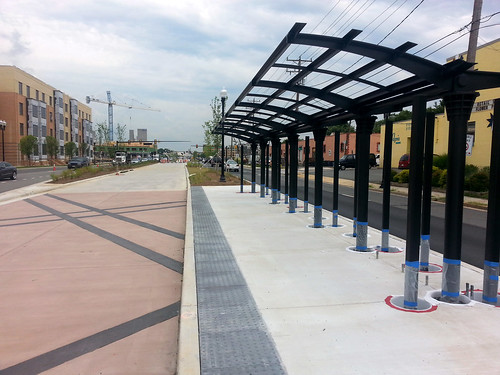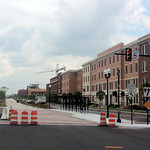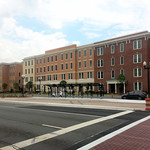|
Special Features





Image Libraries


|
|
Blog
Visible progress on the Crystal City transitwayArlington’s Crystal City streetcar may have been canceled, but work is continuing on the dedicated transitway that would have carried it. Only buses will use this now, but the infrastructure is rising from the ground.
This is the Glebe Road station, in Potomac Yard.
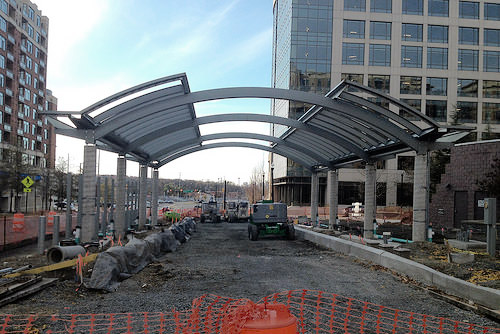
Glebe Road station. Photo by Arlington.
When complete, it will look like this:
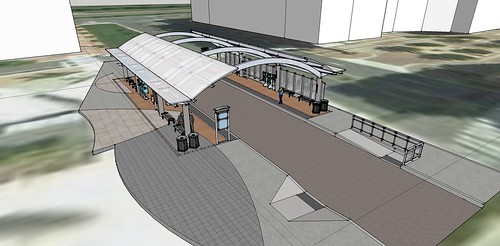
Station rendering. Image by Arlington.
 Cross-posted at Greater Greater Washington. Cross-posted at Greater Greater Washington.
November 28th, 2014 | Permalink
Tags: BRT, streetcar, transportation

Richmond will have BRTBus rapid transit will come to Richmond in 2018. The long-planned Broad Street BRT project won a federal TIGER grant this week to cover half its cost, allowing the project to move forward into final design and construction.

Rendering of Broad Street BRT. Image from the Greater Richmond Transit Company.
Broad Street is Richmond’s most successful transit corridor, and main bus spine. It runs through or near most of Richmond’s densest urban neighborhoods and most important central city hubs. It’s the natural place for rapid transit.
The BRT project will run from the Willow Lawn shopping center in suburban Henrico County, through Virginia Commonwealth University and downtown Richmond, all the way to Rocketts Landing on the city’s east side.
It will use a mix of dedicated curbside bus lanes and a median busway through the busiest sections of the central city, with mixed-traffic operation on either end.
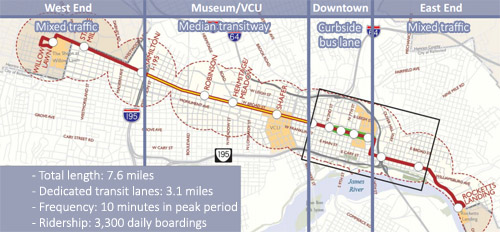
Map of Broad Street BRT. Original image from the GRTC.
Projections say the BRT line will carry about 3,300 riders per day. That’s low compared to the standards of a transit rich metropolis like DC, but it’s huge for a place like Richmond, where there are only about 35,000 total daily bus riders in the entire region.
 Cross-posted at Greater Greater Washington. Cross-posted at Greater Greater Washington.
September 11th, 2014 | Permalink
Tags: BRT, bus, transportation

Photos of Alexandria’s Metroway BRT, open and carrying passengersThe DC region’s first Bus Rapid Transit line opened this weekend. Metroway runs from Crystal City to Braddock Road, using a transitway along Route 1 in Alexandria.
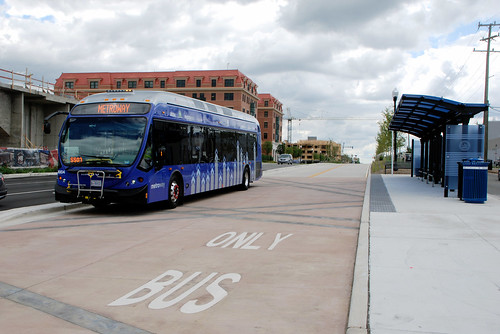
> Continue reading at Greater Greater Washington
or
> See the full flickr set
August 25th, 2014 | Permalink
Tags: BRT, bus, transportation

Photo: An actual bus running in the Route 1 transitwayThis bus is not in service. But it is running in Alexandria’s Metroway BRT corridor, presumably on a test run. It’s pretty exciting to see the region’s first BRT so close to starting.
The BRT opens for real on Sunday, August 24.
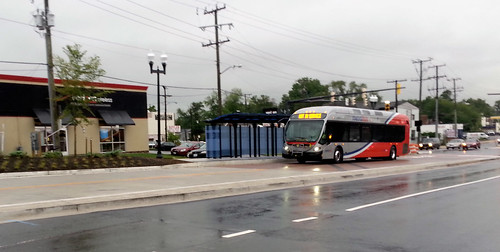
 Cross-posted at Greater Greater Washington. Cross-posted at Greater Greater Washington.
August 12th, 2014 | Permalink
Tags: BRT, bus, transportation

DDOT’s 5-point plan to improve 16th Street buses
DDOT isn’t yet willing to install a bus lane on 16th Street, but the agency is moving forward on a host of other improvements, and will study a bus lane next year.
The 16th Street bus line is bursting at the seams. It carries more than half of rush hour trips on 16th Street. But the buses are slow, and they’re so full that riders in the city’s close-in neighborhoods often can’t board.
Advocates have been pressuring for bus improvements on 16th Street since 2010. ANC Commissioner (and District Council candidate) Kishan Putta has championed the cause. Now, DDOT has adopted a 5-point plan to fix 16th Street.
Here are the 5 points:
Already complete: Signal optimization pilot program: In July 2014, DDOT retimed 44 of the traffic signals along 16th Street to improve their efficiency. After a few weeks of results, it appears to have sped up traffic (including buses). DDOT will continue to evaluate the results the rest of this summer.
August 2014: More articulated buses: Metro will reshuffle its bus fleet, to provide more long “accordion” buses on 16th Street. WMATA will move the articulated buses currently running on the Y series in Maryland to the 70 line in DC, then move the articulated buses currently on the 70 line to 16th Street. The Y series will have shorter buses, but they’ll come more often.
Fall 2014: Longer rush hour operations: DDOT is considering extending the hours of rush hour parking restrictions on 16th Street, to keep more travel lanes open up to an hour longer in each direction. That will keep two lanes open to moving traffic, including buses.
Mid 2015: Transit signal priority & full optimization: By mid 2015, DDOT will expand its signal optimization pilot program to the entire corridor, and install new software that instructs traffic signals to hold a green light a few seconds longer if a bus is about to pass through an intersection. That will speed up buses along the route, so they’re less likely to have to stop at red lights.
2015-2016: Bus lane study: Beginning in 2015, DDOT will begin a comprehensive study of transit improvements along 16th Street, including the potential for bus lanes and other long-term construction projects. The study will take about a year to complete, meaning 2016 is the earliest DDOT could install bus lanes.
None of these 5 points are new. DDOT has been working on them all for some time. But it’s good to have them listed all in one place.
 Cross-posted at Greater Greater Washington. Cross-posted at Greater Greater Washington.
August 11th, 2014 | Permalink
Tags: BRT, bus, transportation

Build protected transit lanes using cycletrack bollardsSimple plastic bollards and slight changes to lanes are enough to turn a regular bike lane into a cycletrack. Could the same trick work for bus lanes?
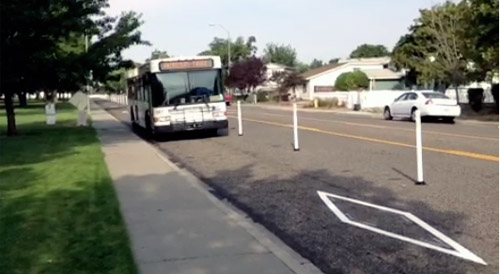
Bollard-protected bus lane in Washington state. Image from Zachary Ziegler on Vine.
DC’s 7th Street and 9th Street curbside bus lanes are famously dysfunctional. Cars use them at will, and pretty much always have. But it doesn’t have to be so.
The same tricks that work to protect bike lanes can also work to protect transit lanes. Plastic bollards, also known as flexposts, send a strong message to car drivers to stay out. The Virginia Department of Transportation even uses them on highways.
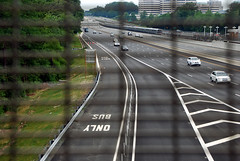 |
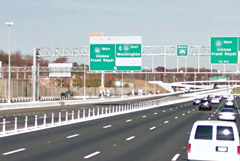 |
Flexposts on a Dulles Toll Road bus lane (left) and the Beltway (right).
Beltway photo from Google. |
Generally speaking, the same complications would exist for bus lanes as exist for cycletracks. Adding bollards takes up a couple of extra feet, parking for cars has to move a lane away from the curb, and you have to find a way to accommodate cars turning at intersections. But mixing zones and other clever solutions have solved those problems for cycletracks, and could work for bus lanes too.
And flexposts aren’t the only cycletrack lesson we can apply to bus lanes. Red paint helps transit lanes the same way green paint helps bike lanes.
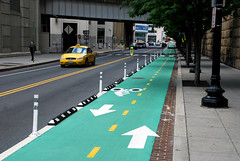 |
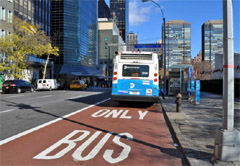 |
| Green means bike, red means transit. Bus lane photo from NYDOT. |
No matter how many special treatments like bollards or red paint an agency applies, median transitways will still function better than curbside transit lanes. Median transitways eliminate the right turn problem altogether (left turns are less common), and puts the transit lanes out of the way of parked cars, or cars pulling over to pick up or drop off passengers.
But median transitways take up more road space, because the medians have to be wide enough for stations. They simply can’t fit on all streets. Where that’s the case, tricks like these can help curbside transit lanes work better than the 7th Street bus lane.
 Cross-posted at Greater Greater Washington. Cross-posted at Greater Greater Washington.
August 7th, 2014 | Permalink
Tags: bike, BRT, bus, lightrail, streetcar, transportation

The Potomac Yard transitway is looking goodConstruction on Alexandria’s Route 1 transitway is coming along, in anticipation of its August 24 opening. These pictures show the station at Route 1 and Custis Avenue.
While Alexandria’s transitway is just about ready, the second phase of the same project, in Arlington, is still a grassy strip. But preliminary construction work started earlier this year, and Arlington officials will host an official groundbreaking on Friday, July 18, at 9:00 am.
 Cross-posted at Greater Greater Washington. Cross-posted at Greater Greater Washington.
July 14th, 2014 | Permalink
Tags: BRT, galleries, streetcar, transportation

The DC region lost 60 miles of bus lanes. It’s time to get them backPrior to 1976 the DC region had at least 60 miles of bus-only lanes, with even more proposed. This map shows where they were.
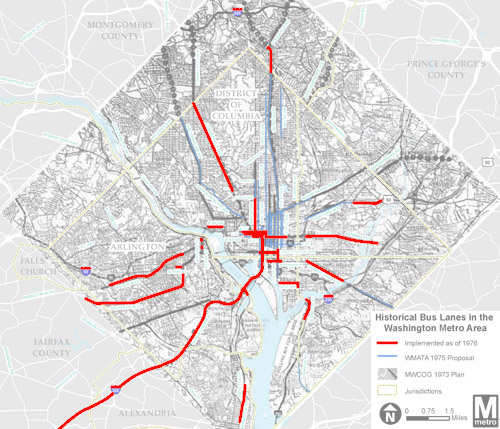
On the map, the red lines show existing bus lanes as of 1976. Blue and black lines show proposals that never materialized. The network reached throughout DC, Northern Virginia, and into Maryland.
Unfortunately, all the bus lanes were converted to other purposes after the Metrorail system was built.
It’s no coincidence or surprise that some of the old bus lanes were on the same streets where they’re now proposed again, like 16th Street and H and I Streets downtown. Those are natural transit corridors, with great need for quality service.
Will we ever get this system back? The region is off to a good start, with moveDC’s 25 miles of proposed transit lanes, and the upcoming Crystal City Potomac Yard Transitway. But the 60-mile system from the 1970s shows we still have a lot of work to do.
 Cross-posted at Greater Greater Washington. Cross-posted at Greater Greater Washington.
July 7th, 2014 | Permalink
Tags: BRT, bus, maps, transportation

BRT comes to Northern Virginia on August 24The first bus rapid transit line in the DC region will officially begin service on August 24.
The “Metroway” route will run from Crystal City to Braddock Road, partly in mixed traffic and partly in a dedicated transitway. A later phase to open in 2015 will extend the route to Pentagon City, and shift more of it into dedicated lanes.
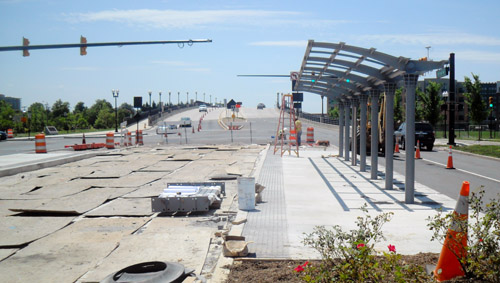
Route 1 Transitway under construction in Alexandria. Photo from Alexandria.
Metroway is a joint project between Alexandria, Arlington, and WMATA. Alexandria and Arlington are building the transitway in two phases, and WMATA will operate the buses.
For now, only the Alexandria phase is ready. Arlington’s phase just began construction and should be finished next year.
But rather than wait until 2015 to start service, WMATA will begin running buses in August, and simply run in mixed traffic through Crystal City until Arlington’s phase is complete.
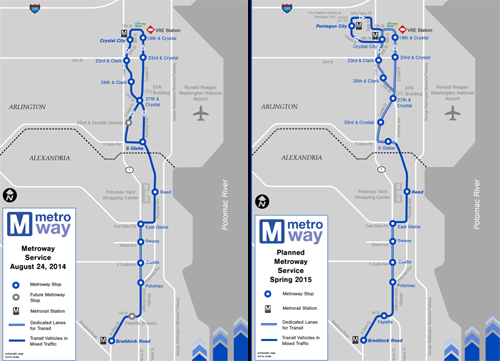
Metroway initial route (left) and route starting in 2015 (right). Image from WMATA.
Metroway will run every 6 minutes at peak times, dropping to every 12 minutes at midday, and every 20 minutes on weekends.
Arlington will eventually convert its portion of the route to streetcar.
 Cross-posted at Greater Greater Washington. Cross-posted at Greater Greater Washington.
July 2nd, 2014 | Permalink
Tags: BRT, streetcar, transportation

Bike racks inside a bus? Speeds up loading, but trades capacityOn San Antonio’s Primo BRT buses, cyclists bring their bikes inside the bus rather than lock them to the front. This speeds up loading and unloading, but reduces Primo’s overall passenger capacity.
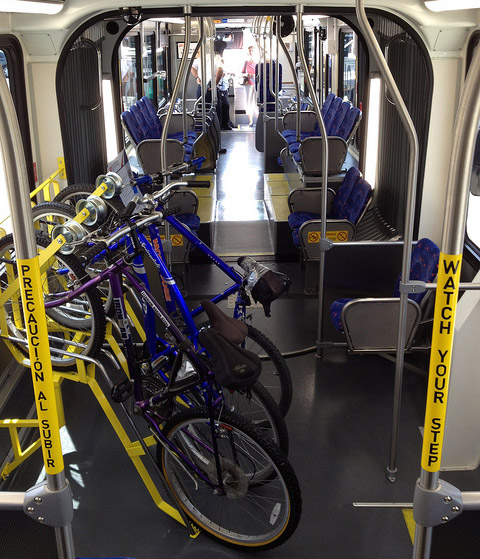
Bike racks on Primo bus in San Antonio. Photo by Stuart Johnson on Flickr.
Primo carries about 6,000 passengers per day, compared to over 20,000 per day on DC’s 16th Street line. So for Primo, the speed versus capacity trade-off tilts to speed.
In DC, our busiest bus lines generally won’t have that option. Although it may make sense in some places, like Montgomery County’s proposed BRT network.
For DC’s more crowded lines, where we cannot justifiably sacrifice limited bus capacity to bikes, rail’s greater spaciousness is an increasingly important advantage. With longer vehicles, we get both the speed advantage and the capacity advantage.
Of course to really speed up buses or trams, give them a dedicated lane. But even in places where that’s not practical, improvements like longer vehicles, more doors, interior bike racks, and off-vehicle fare collection can make a difference, regardless of mode.
June 17th, 2014 | Permalink
Tags: BRT, bus, streetcar, transportation

|
Media





Site
About BeyondDC
Archive 2003-06
Contact
Category Tags:
Partners
|


 Cross-posted at Greater Greater Washington.
Cross-posted at Greater Greater Washington.



















